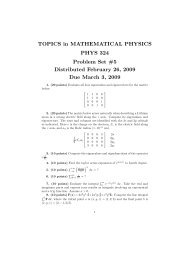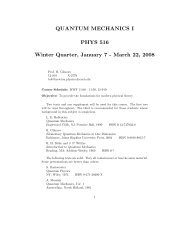The Topology of Chaos - Department of Physics - Drexel University
The Topology of Chaos - Department of Physics - Drexel University
The Topology of Chaos - Department of Physics - Drexel University
Create successful ePaper yourself
Turn your PDF publications into a flip-book with our unique Google optimized e-Paper software.
<strong>The</strong> <strong>Topology</strong><br />
<strong>of</strong> <strong>Chaos</strong><br />
Robert<br />
Gilmore<br />
<strong>The</strong> <strong>Topology</strong> <strong>of</strong> <strong>Chaos</strong><br />
Intro.-01<br />
Intro.-02<br />
Intro.-03<br />
Exp’tal-01<br />
Exp’tal-02<br />
Exp’tal-03<br />
Exp’tal-04<br />
Exp’tal-05<br />
Exp’tal-06<br />
Exp’tal-07<br />
Exp’tal-08<br />
Embed-01<br />
Embed-02<br />
Robert Gilmore<br />
<strong>Physics</strong> <strong>Department</strong><br />
<strong>Drexel</strong> <strong>University</strong><br />
Philadelphia, PA 19104<br />
robert.gilmore@drexel.edu<br />
2011 Brazilian Conference on Dynamics, Control, and Applications<br />
Águas de Lindóia, Sao Paulo, Brazil<br />
August 29 — September 2, 2011<br />
August 16, 2011<br />
Embed-03
Abstract<br />
<strong>The</strong> <strong>Topology</strong><br />
<strong>of</strong> <strong>Chaos</strong><br />
Robert<br />
Gilmore<br />
Intro.-01<br />
Intro.-02<br />
Intro.-03<br />
Exp’tal-01<br />
Exp’tal-02<br />
Exp’tal-03<br />
Exp’tal-04<br />
Exp’tal-05<br />
Exp’tal-06<br />
Exp’tal-07<br />
Exp’tal-08<br />
Embed-01<br />
Embed-02<br />
Embed-03<br />
Data generated by a low-dimensional dynamical system<br />
operating in a chaotic regime can be analyzed using topological<br />
methods. <strong>The</strong> process is (almost) straightforward. On a scalar<br />
time series, the following steps are taken:<br />
1 Unstable periodic orbits are identified;<br />
2 An embedding is constructed; ⋆ ⋆<br />
3 <strong>The</strong> topological organization <strong>of</strong> these periodic orbits is<br />
determined;<br />
4 Some orbits are used to identify an underlying branched<br />
manifold;<br />
5 <strong>The</strong> branched manifold is used as a tool to predict the<br />
remaining topological invariants.<br />
This algorithm has its own built in rejection criterion.
Abstract - Key Point<br />
<strong>The</strong> <strong>Topology</strong><br />
<strong>of</strong> <strong>Chaos</strong><br />
Robert<br />
Gilmore<br />
Intro.-01<br />
Intro.-02<br />
Intro.-03<br />
Exp’tal-01<br />
Exp’tal-02<br />
Exp’tal-03<br />
Exp’tal-04<br />
Exp’tal-05<br />
Exp’tal-06<br />
Exp’tal-07<br />
Exp’tal-08<br />
Embed-01<br />
One s<strong>of</strong>t spot in this analysis program is the embedding step.<br />
Different embeddings can yield different topological results.<br />
This makes the following question exciting:<br />
When you analyze embedded data: How much <strong>of</strong><br />
what you learn is about the embedding and how<br />
much is about the underlying dynamics?<br />
This question has been answered by creating a representation<br />
theory <strong>of</strong> low dimensional strange attractors. It is now possible<br />
to totally disentangle the mechanism generating the underlying<br />
dynamics from topological structure induced by the embedding<br />
step.<br />
Embed-02<br />
Embed-03
Table <strong>of</strong> Contents<br />
<strong>The</strong> <strong>Topology</strong><br />
<strong>of</strong> <strong>Chaos</strong><br />
Robert<br />
Gilmore<br />
Intro.-01<br />
Intro.-02<br />
Intro.-03<br />
Exp’tal-01<br />
Exp’tal-02<br />
Exp’tal-03<br />
Exp’tal-04<br />
Exp’tal-05<br />
Exp’tal-06<br />
Exp’tal-07<br />
Exp’tal-08<br />
Outline<br />
1 Overview<br />
2 Experimental Challenge<br />
3 Embedding Problems<br />
4 Topological Analysis Program<br />
5 Representation <strong>The</strong>ory <strong>of</strong> Strange Attractors<br />
6 Classification <strong>of</strong> Strange Attractors<br />
7 Basis Sets <strong>of</strong> Orbits<br />
8 Bounding Tori<br />
9 Summary<br />
Embed-01<br />
Embed-02<br />
Embed-03
Experimental Schematic<br />
<strong>The</strong> <strong>Topology</strong><br />
<strong>of</strong> <strong>Chaos</strong><br />
Robert<br />
Gilmore<br />
Laser Experimental Arrangement<br />
Intro.-01<br />
Intro.-02<br />
Intro.-03<br />
Exp’tal-01<br />
Exp’tal-02<br />
Exp’tal-03<br />
Exp’tal-04<br />
Exp’tal-05<br />
Exp’tal-06<br />
Exp’tal-07<br />
Exp’tal-08<br />
Embed-01<br />
Embed-02<br />
Embed-03
Real Data<br />
<strong>The</strong> <strong>Topology</strong><br />
<strong>of</strong> <strong>Chaos</strong><br />
Robert<br />
Gilmore<br />
Experimental Data: LSA<br />
Intro.-01<br />
Intro.-02<br />
Intro.-03<br />
Exp’tal-01<br />
Exp’tal-02<br />
Exp’tal-03<br />
Exp’tal-04<br />
Exp’tal-05<br />
Exp’tal-06<br />
Exp’tal-07<br />
Exp’tal-08<br />
Embed-01<br />
Embed-02<br />
Lefranc - Cargese<br />
Embed-03
Ask the Masters<br />
<strong>The</strong> <strong>Topology</strong><br />
<strong>of</strong> <strong>Chaos</strong><br />
Robert<br />
Gilmore<br />
Periodic Orbits are the Key<br />
Intro.-01<br />
Intro.-02<br />
Intro.-03<br />
Exp’tal-01<br />
Exp’tal-02<br />
Exp’tal-03<br />
Exp’tal-04<br />
Exp’tal-05<br />
Exp’tal-06<br />
Exp’tal-07<br />
Exp’tal-08<br />
Embed-01<br />
Embed-02<br />
Embed-03<br />
Joseph Fourier<br />
Linear Systems<br />
Henri Poincare<br />
Nonlinear Systems
Periodic Orbit Surrogates<br />
<strong>The</strong> <strong>Topology</strong><br />
<strong>of</strong> <strong>Chaos</strong><br />
Robert<br />
Gilmore<br />
Intro.-01<br />
Searching for Periodic Orbits<br />
Θ(i, i + p) = |x(i) − x(i + p)|<br />
Intro.-02<br />
Intro.-03<br />
Exp’tal-01<br />
Exp’tal-02<br />
Exp’tal-03<br />
Exp’tal-04<br />
Exp’tal-05<br />
Exp’tal-06<br />
Exp’tal-07<br />
Exp’tal-08<br />
Embed-01<br />
Embed-02<br />
Embed-03
Real Data<br />
<strong>The</strong> <strong>Topology</strong><br />
<strong>of</strong> <strong>Chaos</strong><br />
Robert<br />
Gilmore<br />
“Periodic Orbits” in Real Data<br />
Intro.-01<br />
Intro.-02<br />
Intro.-03<br />
Exp’tal-01<br />
Exp’tal-02<br />
Exp’tal-03<br />
Exp’tal-04<br />
Exp’tal-05<br />
Exp’tal-06<br />
Exp’tal-07<br />
Exp’tal-08<br />
Embed-01<br />
Embed-02<br />
Embed-03
Mechanism<br />
<strong>The</strong> <strong>Topology</strong><br />
<strong>of</strong> <strong>Chaos</strong><br />
Robert<br />
Gilmore<br />
Stretching & Squeezing in a Torus<br />
Intro.-01<br />
Intro.-02<br />
Intro.-03<br />
Exp’tal-01<br />
Exp’tal-02<br />
Exp’tal-03<br />
Exp’tal-04<br />
Exp’tal-05<br />
Exp’tal-06<br />
Exp’tal-07<br />
Exp’tal-08<br />
Embed-01<br />
Embed-02<br />
Embed-03
Time Evolution<br />
<strong>The</strong> <strong>Topology</strong><br />
<strong>of</strong> <strong>Chaos</strong><br />
Robert<br />
Gilmore<br />
Intro.-01<br />
Rotating the Poincaré Section<br />
around the axis <strong>of</strong> the torus<br />
Intro.-02<br />
Intro.-03<br />
Exp’tal-01<br />
Exp’tal-02<br />
Exp’tal-03<br />
Exp’tal-04<br />
Exp’tal-05<br />
Exp’tal-06<br />
Exp’tal-07<br />
Exp’tal-08<br />
Embed-01<br />
Embed-02<br />
Embed-03
Time Evolution<br />
<strong>The</strong> <strong>Topology</strong><br />
<strong>of</strong> <strong>Chaos</strong><br />
Robert<br />
Gilmore<br />
Intro.-01<br />
Rotating the Poincaré Section<br />
around the axis <strong>of</strong> the torus<br />
Intro.-02<br />
Intro.-03<br />
Exp’tal-01<br />
Exp’tal-02<br />
Exp’tal-03<br />
Exp’tal-04<br />
Exp’tal-05<br />
Exp’tal-06<br />
Exp’tal-07<br />
Exp’tal-08<br />
Embed-01<br />
Embed-02<br />
Embed-03<br />
Lefranc - Cargese
Embeddings<br />
<strong>The</strong> <strong>Topology</strong><br />
<strong>of</strong> <strong>Chaos</strong><br />
Robert<br />
Gilmore<br />
Intro.-01<br />
Creating Something from “Nothing”<br />
scalar time series −→ vector time series<br />
Intro.-02<br />
Intro.-03<br />
Exp’tal-01<br />
Exp’tal-02<br />
Exp’tal-03<br />
Exp’tal-04<br />
Exp’tal-05<br />
Embedding is an Art.<br />
Perhaps more like Black Magic.<br />
<strong>The</strong>re are many ways to conjure an embedding.<br />
Exp’tal-06<br />
Exp’tal-07<br />
Exp’tal-08<br />
Embed-01<br />
Embed-02<br />
Embed-03
Embeddings<br />
<strong>The</strong> <strong>Topology</strong><br />
<strong>of</strong> <strong>Chaos</strong><br />
Robert<br />
Gilmore<br />
Intro.-01<br />
Varieties <strong>of</strong> Embeddings<br />
x(i) → (y 1 (i), y 2 (i), y 3 (i), · · · )<br />
Intro.-02<br />
Intro.-03<br />
Exp’tal-01<br />
Exp’tal-02<br />
Exp’tal-03<br />
Exp’tal-04<br />
Exp’tal-05<br />
Exp’tal-06<br />
Exp’tal-07<br />
Exp’tal-08<br />
Embed-01<br />
Embed-02<br />
Delay (x(i), x(i − τ 1 ), x(i − τ 2 ), x(i − τ 3 ), · · · )<br />
Delay y j (i) = x(i − [j − 1] τ) τ, N<br />
Differential y 1 = x, y 2 = dx/dt, y 3 = d 2 x/dt 2 , · · ·<br />
Int. − Diff. y 1 = ∫ x<br />
−∞ dx, y 2 = x, y 3 = dx/dt, · · ·<br />
SVD<br />
EoM<br />
Hilbert − Tsf.<br />
“Circular ′′<br />
Knotted<br />
Other<br />
Embed-03
Embeddings<br />
<strong>The</strong> <strong>Topology</strong><br />
<strong>of</strong> <strong>Chaos</strong><br />
Robert<br />
Gilmore<br />
Intro.-01<br />
Intro.-02<br />
Intro.-03<br />
Exp’tal-01<br />
Exp’tal-02<br />
Exp’tal-03<br />
Exp’tal-04<br />
Exp’tal-05<br />
Exp’tal-06<br />
Exp’tal-07<br />
Circular and Knotted Embeddings<br />
If there is a “hole in the middle” then parameterize the scalar<br />
observable by an angle θ: x(t) → x(θ)<br />
Introduce Knot coordinates (“harmonic knots”)<br />
K(θ) = (ξ(θ), η(θ), ζ(θ)) = K(θ + 2π)<br />
Repere Mobile: {t(θ), n(θ), b(θ)}<br />
x(t) → x(θ) → K(θ) + y 1 n(θ) + y 2 b(θ)<br />
Exp’tal-08<br />
Embed-01<br />
Embed-02<br />
Embed-03
Some Knotted Embeddings<br />
<strong>The</strong> <strong>Topology</strong><br />
<strong>of</strong> <strong>Chaos</strong><br />
Robert<br />
Gilmore<br />
Intro.-01<br />
Intro.-02<br />
Intro.-03<br />
Exp’tal-01<br />
Exp’tal-02<br />
Exp’tal-03<br />
Exp’tal-04<br />
Exp’tal-05<br />
Exp’tal-06<br />
Exp’tal-07<br />
Exp’tal-08<br />
Embed-01<br />
Embed-02<br />
Embed-03<br />
Simple “Unknot”<br />
Trefoil Knot
More Knotted Embeddings<br />
<strong>The</strong> <strong>Topology</strong><br />
<strong>of</strong> <strong>Chaos</strong><br />
Robert<br />
Gilmore<br />
Intro.-01<br />
Intro.-02<br />
Intro.-03<br />
Exp’tal-01<br />
Exp’tal-02<br />
Exp’tal-03<br />
Exp’tal-04<br />
Exp’tal-05<br />
Exp’tal-06<br />
Exp’tal-07<br />
Exp’tal-08<br />
Embed-01<br />
Embed-02<br />
Embed-03<br />
Granny Knot<br />
Square Knot
<strong>Chaos</strong><br />
<strong>The</strong> <strong>Topology</strong><br />
<strong>of</strong> <strong>Chaos</strong><br />
Robert<br />
Gilmore<br />
Intro.-01<br />
Intro.-02<br />
Intro.-03<br />
Exp’tal-01<br />
Exp’tal-02<br />
Exp’tal-03<br />
Exp’tal-04<br />
Exp’tal-05<br />
Exp’tal-06<br />
Exp’tal-07<br />
Motion that is<br />
• Deterministic:<br />
• Recurrent<br />
• Non Periodic<br />
<strong>Chaos</strong><br />
dx<br />
dt = f(x)<br />
• Sensitive to Initial Conditions<br />
Exp’tal-08<br />
Embed-01<br />
Embed-02<br />
Embed-03
Strange Attractor<br />
<strong>The</strong> <strong>Topology</strong><br />
<strong>of</strong> <strong>Chaos</strong><br />
Robert<br />
Gilmore<br />
Intro.-01<br />
Intro.-02<br />
Intro.-03<br />
Exp’tal-01<br />
Exp’tal-02<br />
Exp’tal-03<br />
Exp’tal-04<br />
Exp’tal-05<br />
Exp’tal-06<br />
Exp’tal-07<br />
Exp’tal-08<br />
Strange Attractor<br />
<strong>The</strong> Ω limit set <strong>of</strong> the flow. <strong>The</strong>re are<br />
unstable periodic orbits “in” the<br />
strange attractor. <strong>The</strong>y are<br />
• “Abundant”<br />
• Outline the Strange Attractor<br />
• Are the Skeleton <strong>of</strong> the Strange<br />
Attractor<br />
Embed-01<br />
Embed-02<br />
Embed-03
Skeletons<br />
<strong>The</strong> <strong>Topology</strong><br />
<strong>of</strong> <strong>Chaos</strong><br />
Robert<br />
Gilmore<br />
UPOs Outline Strange Attractors<br />
Intro.-01<br />
Intro.-02<br />
Intro.-03<br />
Exp’tal-01<br />
Exp’tal-02<br />
Exp’tal-03<br />
Exp’tal-04<br />
Exp’tal-05<br />
Exp’tal-06<br />
Exp’tal-07<br />
Exp’tal-08<br />
Embed-01<br />
Embed-02<br />
Embed-03<br />
BZ reaction
Skeletons<br />
<strong>The</strong> <strong>Topology</strong><br />
<strong>of</strong> <strong>Chaos</strong><br />
Robert<br />
Gilmore<br />
UPOs Outline Strange attractors<br />
Intro.-01<br />
Intro.-02<br />
Intro.-03<br />
Exp’tal-01<br />
Exp’tal-02<br />
Exp’tal-03<br />
Exp’tal-04<br />
Exp’tal-05<br />
Exp’tal-06<br />
Exp’tal-07<br />
Exp’tal-08<br />
Embed-01<br />
Embed-02<br />
Embed-03<br />
Laser w. Modulated Losses
Organization<br />
<strong>The</strong> <strong>Topology</strong><br />
<strong>of</strong> <strong>Chaos</strong><br />
Robert<br />
Gilmore<br />
Intro.-01<br />
How Are Orbits Organized<br />
Ask the Master:<br />
Intro.-02<br />
Intro.-03<br />
Exp’tal-01<br />
Exp’tal-02<br />
Exp’tal-03<br />
Exp’tal-04<br />
Exp’tal-05<br />
Exp’tal-06<br />
Exp’tal-07<br />
Exp’tal-08<br />
Embed-01<br />
Embed-02<br />
Embed-03<br />
Carl Friedrich Gauss
Dynamics and <strong>Topology</strong><br />
<strong>The</strong> <strong>Topology</strong><br />
<strong>of</strong> <strong>Chaos</strong><br />
Robert<br />
Gilmore<br />
Intro.-01<br />
Organization <strong>of</strong> UPOs in R 3 :<br />
Gauss Linking Number<br />
Intro.-02<br />
Intro.-03<br />
Exp’tal-01<br />
Exp’tal-02<br />
Exp’tal-03<br />
LN(A, B) = 1 ∮ ∮ (rA − r B )·dr A ×dr B<br />
4π |r A − r B | 3<br />
Exp’tal-04<br />
Exp’tal-05<br />
Exp’tal-06<br />
Exp’tal-07<br />
Exp’tal-08<br />
# Interpretations <strong>of</strong> LN ≃ # Mathematicians in World<br />
Embed-01<br />
Embed-02<br />
Embed-03
Linking Numbers<br />
<strong>The</strong> <strong>Topology</strong><br />
<strong>of</strong> <strong>Chaos</strong><br />
Robert<br />
Gilmore<br />
Linking Number <strong>of</strong> Two UPOs<br />
Intro.-01<br />
Intro.-02<br />
Intro.-03<br />
Exp’tal-01<br />
Exp’tal-02<br />
Exp’tal-03<br />
Exp’tal-04<br />
Exp’tal-05<br />
Exp’tal-06<br />
Exp’tal-07<br />
Exp’tal-08<br />
Embed-01<br />
Embed-02<br />
Embed-03<br />
Lefranc - Cargese
Evolution in Phase Space<br />
<strong>The</strong> <strong>Topology</strong><br />
<strong>of</strong> <strong>Chaos</strong><br />
Robert<br />
Gilmore<br />
One Stretch-&-Squeeze Mechanism<br />
Intro.-01<br />
Intro.-02<br />
Intro.-03<br />
Exp’tal-01<br />
Exp’tal-02<br />
Exp’tal-03<br />
Exp’tal-04<br />
Exp’tal-05<br />
Exp’tal-06<br />
Exp’tal-07<br />
Exp’tal-08<br />
Embed-01<br />
Embed-02<br />
Embed-03
Motion <strong>of</strong> Blobs in Phase Space<br />
<strong>The</strong> <strong>Topology</strong><br />
<strong>of</strong> <strong>Chaos</strong><br />
Robert<br />
Gilmore<br />
Another Stretch-&-Squeeze Mechanism<br />
Intro.-01<br />
Intro.-02<br />
Intro.-03<br />
Exp’tal-01<br />
Exp’tal-02<br />
Exp’tal-03<br />
Exp’tal-04<br />
Exp’tal-05<br />
Exp’tal-06<br />
Exp’tal-07<br />
Exp’tal-08<br />
Embed-01<br />
Embed-02<br />
“Lorenz Mechanism”<br />
Embed-03
Motion <strong>of</strong> Blobs in Phase Space<br />
<strong>The</strong> <strong>Topology</strong><br />
<strong>of</strong> <strong>Chaos</strong><br />
Robert<br />
Gilmore<br />
Stretching — Folding<br />
Intro.-01<br />
Intro.-02<br />
Intro.-03<br />
Exp’tal-01<br />
Exp’tal-02<br />
Exp’tal-03<br />
Exp’tal-04<br />
Exp’tal-05<br />
Exp’tal-06<br />
Exp’tal-07<br />
Exp’tal-08<br />
Embed-01<br />
Embed-02<br />
Embed-03
Collapse Along the Stable Manifold<br />
<strong>The</strong> <strong>Topology</strong><br />
<strong>of</strong> <strong>Chaos</strong><br />
Robert<br />
Gilmore<br />
Intro.-01<br />
Intro.-02<br />
Intro.-03<br />
Exp’tal-01<br />
Birman - Williams Projection<br />
Identify x and y if<br />
lim |x(t) − y(t)| → 0<br />
t→∞<br />
Exp’tal-02<br />
Exp’tal-03<br />
Exp’tal-04<br />
Exp’tal-05<br />
Exp’tal-06<br />
Exp’tal-07<br />
Exp’tal-08<br />
Embed-01<br />
Embed-02<br />
Embed-03
Fundamental <strong>The</strong>orem<br />
<strong>The</strong> <strong>Topology</strong><br />
<strong>of</strong> <strong>Chaos</strong><br />
Robert<br />
Gilmore<br />
Birman - Williams <strong>The</strong>orem<br />
Intro.-01<br />
Intro.-02<br />
Intro.-03<br />
Exp’tal-01<br />
If:<br />
Exp’tal-02<br />
Exp’tal-03<br />
Exp’tal-04<br />
Exp’tal-05<br />
Exp’tal-06<br />
<strong>The</strong>n:<br />
Exp’tal-07<br />
Exp’tal-08<br />
Embed-01<br />
Embed-02<br />
Embed-03
Fundamental <strong>The</strong>orem<br />
<strong>The</strong> <strong>Topology</strong><br />
<strong>of</strong> <strong>Chaos</strong><br />
Robert<br />
Gilmore<br />
Birman - Williams <strong>The</strong>orem<br />
Intro.-01<br />
Intro.-02<br />
Intro.-03<br />
Exp’tal-01<br />
Exp’tal-02<br />
Exp’tal-03<br />
If:<br />
Certain Assumptions<br />
Exp’tal-04<br />
Exp’tal-05<br />
Exp’tal-06<br />
<strong>The</strong>n:<br />
Exp’tal-07<br />
Exp’tal-08<br />
Embed-01<br />
Embed-02<br />
Embed-03
Fundamental <strong>The</strong>orem<br />
<strong>The</strong> <strong>Topology</strong><br />
<strong>of</strong> <strong>Chaos</strong><br />
Robert<br />
Gilmore<br />
Birman - Williams <strong>The</strong>orem<br />
Intro.-01<br />
Intro.-02<br />
Intro.-03<br />
Exp’tal-01<br />
Exp’tal-02<br />
Exp’tal-03<br />
If:<br />
Certain Assumptions<br />
Exp’tal-04<br />
Exp’tal-05<br />
Exp’tal-06<br />
Exp’tal-07<br />
Exp’tal-08<br />
Embed-01<br />
Embed-02<br />
Embed-03<br />
<strong>The</strong>n:<br />
Specific Conclusions
Birman-Williams <strong>The</strong>orem<br />
<strong>The</strong> <strong>Topology</strong><br />
<strong>of</strong> <strong>Chaos</strong><br />
Robert<br />
Gilmore<br />
Intro.-01<br />
Intro.-02<br />
Intro.-03<br />
Exp’tal-01<br />
Exp’tal-02<br />
Exp’tal-03<br />
Exp’tal-04<br />
Exp’tal-05<br />
Assumptions, B-W <strong>The</strong>orem<br />
A flow Φ t (x)<br />
• on R n<br />
is dissipative, n = 3, so that<br />
λ 1 > 0, λ 2 = 0, λ 3 < 0.<br />
• Generates a hyperbolic strange<br />
attractor SA<br />
Exp’tal-06<br />
Exp’tal-07<br />
Exp’tal-08<br />
Embed-01<br />
IMPORTANT: <strong>The</strong> underlined assumptions can be relaxed.<br />
Embed-02<br />
Embed-03
Birman-Williams <strong>The</strong>orem<br />
<strong>The</strong> <strong>Topology</strong><br />
<strong>of</strong> <strong>Chaos</strong><br />
Robert<br />
Gilmore<br />
Intro.-01<br />
Intro.-02<br />
Intro.-03<br />
Exp’tal-01<br />
Exp’tal-02<br />
Exp’tal-03<br />
Exp’tal-04<br />
Exp’tal-05<br />
Exp’tal-06<br />
Exp’tal-07<br />
Exp’tal-08<br />
Conclusions, B-W <strong>The</strong>orem<br />
• <strong>The</strong> projection maps the strange attractor SA onto a<br />
2-dimensional branched manifold BM and the flow Φ t (x)<br />
on SA to a semiflow Φ(x) t on BM.<br />
• UPOs <strong>of</strong> Φ t (x) on SA are in 1-1 correspondence with<br />
UPOs <strong>of</strong> Φ(x) t on BM. Moreover, every link <strong>of</strong> UPOs <strong>of</strong><br />
(Φ t (x), SA) is isotopic to the correspond link <strong>of</strong> UPOs <strong>of</strong><br />
(Φ(x) t , BM).<br />
Remark: “One <strong>of</strong> the few theorems useful to experimentalists.”<br />
Embed-01<br />
Embed-02<br />
Embed-03
A Very Common Mechanism<br />
<strong>The</strong> <strong>Topology</strong><br />
<strong>of</strong> <strong>Chaos</strong><br />
Robert<br />
Gilmore<br />
Intro.-01<br />
Intro.-02<br />
Intro.-03<br />
Exp’tal-01<br />
Exp’tal-02<br />
Exp’tal-03<br />
Exp’tal-04<br />
Exp’tal-05<br />
Exp’tal-06<br />
Exp’tal-07<br />
Exp’tal-08<br />
Embed-01<br />
Embed-02<br />
Embed-03<br />
Attractor<br />
Rössler:<br />
Branched Manifold
A Mechanism with Symmetry<br />
<strong>The</strong> <strong>Topology</strong><br />
<strong>of</strong> <strong>Chaos</strong><br />
Robert<br />
Gilmore<br />
Intro.-01<br />
Intro.-02<br />
Intro.-03<br />
Exp’tal-01<br />
Exp’tal-02<br />
Exp’tal-03<br />
Exp’tal-04<br />
Exp’tal-05<br />
Exp’tal-06<br />
Exp’tal-07<br />
Exp’tal-08<br />
Embed-01<br />
Embed-02<br />
Embed-03<br />
Attractor<br />
Lorenz:<br />
Branched Manifold
Examples <strong>of</strong> Branched Manifolds<br />
<strong>The</strong> <strong>Topology</strong><br />
<strong>of</strong> <strong>Chaos</strong><br />
Robert<br />
Gilmore<br />
Inequivalent Branched Manifolds<br />
Intro.-01<br />
Intro.-02<br />
Intro.-03<br />
Exp’tal-01<br />
Exp’tal-02<br />
Exp’tal-03<br />
Exp’tal-04<br />
Exp’tal-05<br />
Exp’tal-06<br />
Exp’tal-07<br />
Exp’tal-08<br />
Embed-01<br />
Embed-02<br />
Embed-03
Aufbau Princip for Branched Manifolds<br />
<strong>The</strong> <strong>Topology</strong><br />
<strong>of</strong> <strong>Chaos</strong><br />
Robert<br />
Gilmore<br />
Any branched manifold can be built up from stretching<br />
and squeezing units<br />
Intro.-01<br />
Intro.-02<br />
Intro.-03<br />
Exp’tal-01<br />
Exp’tal-02<br />
Exp’tal-03<br />
Exp’tal-04<br />
Exp’tal-05<br />
Exp’tal-06<br />
Exp’tal-07<br />
Exp’tal-08<br />
Embed-01<br />
Embed-02<br />
subject to the conditions:<br />
• Outputs to Inputs<br />
• No Free Ends<br />
Embed-03
Dynamics and <strong>Topology</strong><br />
<strong>The</strong> <strong>Topology</strong><br />
<strong>of</strong> <strong>Chaos</strong><br />
Robert<br />
Gilmore<br />
Rossler System<br />
Intro.-01<br />
Intro.-02<br />
Intro.-03<br />
Exp’tal-01<br />
Exp’tal-02<br />
Exp’tal-03<br />
Exp’tal-04<br />
Exp’tal-05<br />
Exp’tal-06<br />
Exp’tal-07<br />
Exp’tal-08<br />
Embed-01<br />
Embed-02<br />
Embed-03
Dynamics and <strong>Topology</strong><br />
<strong>The</strong> <strong>Topology</strong><br />
<strong>of</strong> <strong>Chaos</strong><br />
Robert<br />
Gilmore<br />
Lorenz System<br />
Intro.-01<br />
Intro.-02<br />
Intro.-03<br />
Exp’tal-01<br />
Exp’tal-02<br />
Exp’tal-03<br />
Exp’tal-04<br />
Exp’tal-05<br />
Exp’tal-06<br />
Exp’tal-07<br />
Exp’tal-08<br />
Embed-01<br />
Embed-02<br />
Embed-03
Dynamics and <strong>Topology</strong><br />
<strong>The</strong> <strong>Topology</strong><br />
<strong>of</strong> <strong>Chaos</strong><br />
Robert<br />
Gilmore<br />
Poincaré Smiles at Us in R 3<br />
Intro.-01<br />
Intro.-02<br />
Intro.-03<br />
Exp’tal-01<br />
Exp’tal-02<br />
Exp’tal-03<br />
Exp’tal-04<br />
Exp’tal-05<br />
• Determine organization <strong>of</strong> UPOs ⇒<br />
• Determine branched manifold ⇒<br />
• Determine equivalence class <strong>of</strong> SA<br />
Exp’tal-06<br />
Exp’tal-07<br />
Exp’tal-08<br />
Embed-01<br />
Embed-02<br />
Embed-03
Topological Analysis Program<br />
<strong>The</strong> <strong>Topology</strong><br />
<strong>of</strong> <strong>Chaos</strong><br />
Robert<br />
Gilmore<br />
Intro.-01<br />
Intro.-02<br />
Intro.-03<br />
Exp’tal-01<br />
Exp’tal-02<br />
Exp’tal-03<br />
Exp’tal-04<br />
Exp’tal-05<br />
Exp’tal-06<br />
Exp’tal-07<br />
Exp’tal-08<br />
Embed-01<br />
Embed-02<br />
Embed-03<br />
Topological Analysis Program<br />
Locate Periodic Orbits<br />
Create an Embedding<br />
Determine Topological Invariants (LN)<br />
Identify a Branched Manifold<br />
Verify the Branched Manifold<br />
—————————————————————————-<br />
Model the Dynamics<br />
Validate the Model
Locate UPOs<br />
<strong>The</strong> <strong>Topology</strong><br />
<strong>of</strong> <strong>Chaos</strong><br />
Robert<br />
Gilmore<br />
Method <strong>of</strong> Close Returns<br />
Intro.-01<br />
Intro.-02<br />
Intro.-03<br />
Exp’tal-01<br />
Exp’tal-02<br />
Exp’tal-03<br />
Exp’tal-04<br />
Exp’tal-05<br />
Exp’tal-06<br />
Exp’tal-07<br />
Exp’tal-08<br />
Embed-01<br />
Embed-02<br />
Embed-03
Embeddings<br />
<strong>The</strong> <strong>Topology</strong><br />
<strong>of</strong> <strong>Chaos</strong><br />
Robert<br />
Gilmore<br />
Intro.-01<br />
Intro.-02<br />
Intro.-03<br />
Exp’tal-01<br />
Exp’tal-02<br />
Exp’tal-03<br />
Exp’tal-04<br />
Exp’tal-05<br />
Embeddings<br />
Many Methods: Time Delay, Differential, Hilbert Transforms,<br />
SVD, Mixtures, ...<br />
Tests for Embeddings: Geometric, Dynamic, Topological †<br />
None Good<br />
We Demand a 3 Dimensional Embedding<br />
Exp’tal-06<br />
Exp’tal-07<br />
Exp’tal-08<br />
Embed-01<br />
Embed-02<br />
Embed-03
Determine Topological Invariants<br />
<strong>The</strong> <strong>Topology</strong><br />
<strong>of</strong> <strong>Chaos</strong><br />
Robert<br />
Gilmore<br />
Compute Table <strong>of</strong> Expt’l LN<br />
Intro.-01<br />
Intro.-02<br />
Intro.-03<br />
Exp’tal-01<br />
Exp’tal-02<br />
Exp’tal-03<br />
Exp’tal-04<br />
Exp’tal-05<br />
Exp’tal-06<br />
Exp’tal-07<br />
Exp’tal-08<br />
Embed-01<br />
Embed-02<br />
Embed-03
Determine Topological Invariants<br />
<strong>The</strong> <strong>Topology</strong><br />
<strong>of</strong> <strong>Chaos</strong><br />
Robert<br />
Gilmore<br />
Compare w. LN From Various BM<br />
Intro.-01<br />
Intro.-02<br />
Intro.-03<br />
Exp’tal-01<br />
Exp’tal-02<br />
Exp’tal-03<br />
Exp’tal-04<br />
Exp’tal-05<br />
Exp’tal-06<br />
Exp’tal-07<br />
Exp’tal-08<br />
Embed-01<br />
Embed-02<br />
Embed-03
Determine Topological Invariants<br />
<strong>The</strong> <strong>Topology</strong><br />
<strong>of</strong> <strong>Chaos</strong><br />
Robert<br />
Gilmore<br />
Guess Branched Manifold<br />
Intro.-01<br />
Intro.-02<br />
Intro.-03<br />
Exp’tal-01<br />
Exp’tal-02<br />
Exp’tal-03<br />
Exp’tal-04<br />
Exp’tal-05<br />
Exp’tal-06<br />
Exp’tal-07<br />
Exp’tal-08<br />
Embed-01<br />
Embed-02<br />
Embed-03<br />
Lefranc - Cargese
Determine Topological Invariants<br />
<strong>The</strong> <strong>Topology</strong><br />
<strong>of</strong> <strong>Chaos</strong><br />
Robert<br />
Gilmore<br />
Intro.-01<br />
Intro.-02<br />
Intro.-03<br />
Exp’tal-01<br />
Exp’tal-02<br />
Exp’tal-03<br />
Identification & ‘Confirmation’<br />
• BM Identified by LN <strong>of</strong> small number <strong>of</strong> orbits<br />
• Table <strong>of</strong> LN GROSSLY overdetermined<br />
• Predict LN <strong>of</strong> additional orbits<br />
• Rejection criterion (Reject or Fail to Reject)<br />
Exp’tal-04<br />
Exp’tal-05<br />
Exp’tal-06<br />
Exp’tal-07<br />
Exp’tal-08<br />
Embed-01<br />
Embed-02<br />
Embed-03
Determine Topological Invariants<br />
<strong>The</strong> <strong>Topology</strong><br />
<strong>of</strong> <strong>Chaos</strong><br />
Robert<br />
Gilmore<br />
Intro.-01<br />
Intro.-02<br />
Intro.-03<br />
Exp’tal-01<br />
What Do We Learn?<br />
• BM Depends on Embedding<br />
• Some things depend on embedding, some don’t<br />
• Depends on Embedding: Global Torsion, Parity, ..<br />
• Independent <strong>of</strong> Embedding: Mechanism<br />
Exp’tal-02<br />
Exp’tal-03<br />
Exp’tal-04<br />
Exp’tal-05<br />
Exp’tal-06<br />
Exp’tal-07<br />
Exp’tal-08<br />
Embed-01<br />
Embed-02<br />
Embed-03
Perestroikas <strong>of</strong> Strange Attractors<br />
<strong>The</strong> <strong>Topology</strong><br />
<strong>of</strong> <strong>Chaos</strong><br />
Robert<br />
Gilmore<br />
Evolution Under Parameter Change<br />
Intro.-01<br />
Intro.-02<br />
Intro.-03<br />
Exp’tal-01<br />
Exp’tal-02<br />
Exp’tal-03<br />
Exp’tal-04<br />
Exp’tal-05<br />
Exp’tal-06<br />
Exp’tal-07<br />
Exp’tal-08<br />
Embed-01<br />
Embed-02<br />
Embed-03<br />
Lefranc - Cargese
Perestroikas <strong>of</strong> Strange Attractors<br />
<strong>The</strong> <strong>Topology</strong><br />
<strong>of</strong> <strong>Chaos</strong><br />
Robert<br />
Gilmore<br />
Evolution Under Parameter Change<br />
Intro.-01<br />
Intro.-02<br />
Intro.-03<br />
Exp’tal-01<br />
Exp’tal-02<br />
Exp’tal-03<br />
Exp’tal-04<br />
Exp’tal-05<br />
Exp’tal-06<br />
Exp’tal-07<br />
Exp’tal-08<br />
Embed-01<br />
Embed-02<br />
Embed-03<br />
Lefranc - Cargese
Perestroikas <strong>of</strong> Strange Attractors<br />
<strong>The</strong> <strong>Topology</strong><br />
<strong>of</strong> <strong>Chaos</strong><br />
Robert<br />
Gilmore<br />
Evolution Under Parameter Change<br />
Intro.-01<br />
Intro.-02<br />
Intro.-03<br />
Exp’tal-01<br />
Exp’tal-02<br />
Exp’tal-03<br />
Exp’tal-04<br />
Exp’tal-05<br />
Exp’tal-06<br />
Exp’tal-07<br />
Exp’tal-08<br />
Embed-01<br />
Embed-02<br />
Used and Martin — Zaragosa<br />
Embed-03
Perestroikas <strong>of</strong> Strange Attractors<br />
<strong>The</strong> <strong>Topology</strong><br />
<strong>of</strong> <strong>Chaos</strong><br />
Robert<br />
Gilmore<br />
Evolution Under Parameter Change<br />
Intro.-01<br />
Intro.-02<br />
Intro.-03<br />
Exp’tal-01<br />
Exp’tal-02<br />
Exp’tal-03<br />
Exp’tal-04<br />
Exp’tal-05<br />
Exp’tal-06<br />
Exp’tal-07<br />
Exp’tal-08<br />
Embed-01<br />
Embed-02<br />
Embed-03<br />
Used and Martin — Zaragosa
An Unexpected Benefit<br />
<strong>The</strong> <strong>Topology</strong><br />
<strong>of</strong> <strong>Chaos</strong><br />
Robert<br />
Gilmore<br />
Analysis <strong>of</strong> Nonstationary Data<br />
Intro.-01<br />
Intro.-02<br />
Intro.-03<br />
Exp’tal-01<br />
Exp’tal-02<br />
Exp’tal-03<br />
Exp’tal-04<br />
Exp’tal-05<br />
Exp’tal-06<br />
Exp’tal-07<br />
Exp’tal-08<br />
Embed-01<br />
Embed-02<br />
Lefranc - Cargese<br />
Embed-03
Our Hope → Now a Result<br />
<strong>The</strong> <strong>Topology</strong><br />
<strong>of</strong> <strong>Chaos</strong><br />
Robert<br />
Gilmore<br />
Intro.-01<br />
Compare with<br />
Original Objectives<br />
Intro.-02<br />
Intro.-03<br />
Exp’tal-01<br />
Exp’tal-02<br />
Exp’tal-03<br />
Exp’tal-04<br />
Exp’tal-05<br />
Exp’tal-06<br />
Construct a simple, algorithmic procedure for:<br />
Classifying strange attractors<br />
Extracting classification information<br />
from experimental signals.<br />
Exp’tal-07<br />
Exp’tal-08<br />
Embed-01<br />
Embed-02<br />
Embed-03
Representations<br />
<strong>The</strong> <strong>Topology</strong><br />
<strong>of</strong> <strong>Chaos</strong><br />
Robert<br />
Gilmore<br />
Intro.-01<br />
Intro.-02<br />
Intro.-03<br />
Exp’tal-01<br />
Exp’tal-02<br />
Exp’tal-03<br />
Exp’tal-04<br />
Exp’tal-05<br />
Exp’tal-06<br />
Exp’tal-07<br />
Representations<br />
An embedding creates a diffeomorphism between an<br />
(‘invisible’) dynamics in someone’s laboratory and a (‘visible’)<br />
attractor in somebody’s computer.<br />
Embeddings provide a representation <strong>of</strong> an attractor.<br />
Equivalence is by Isotopy.<br />
Irreducible is by Dimension<br />
Exp’tal-08<br />
Embed-01<br />
Embed-02<br />
Embed-03
Representations<br />
<strong>The</strong> <strong>Topology</strong><br />
<strong>of</strong> <strong>Chaos</strong><br />
Robert<br />
Gilmore<br />
Intro.-01<br />
Intro.-02<br />
Intro.-03<br />
Exp’tal-01<br />
Exp’tal-02<br />
Representations<br />
We know about representations from studies <strong>of</strong> groups and<br />
algebras.<br />
We use this knowledge as a guiding light.<br />
Exp’tal-03<br />
Exp’tal-04<br />
Exp’tal-05<br />
Exp’tal-06<br />
Exp’tal-07<br />
Exp’tal-08<br />
Embed-01<br />
Embed-02<br />
Embed-03
Representation Labels<br />
<strong>The</strong> <strong>Topology</strong><br />
<strong>of</strong> <strong>Chaos</strong><br />
Robert<br />
Gilmore<br />
Intro.-01<br />
Intro.-02<br />
Intro.-03<br />
Inequivalent Irreducible Representations<br />
Irreducible Representations <strong>of</strong> 3-dimensional Genus-one<br />
attractors are distinguished by three topological labels:<br />
Exp’tal-01<br />
Exp’tal-02<br />
Exp’tal-03<br />
Exp’tal-04<br />
Exp’tal-05<br />
Parity<br />
Global Torsion<br />
Knot Type<br />
P<br />
N<br />
KT<br />
Exp’tal-06<br />
Exp’tal-07<br />
Exp’tal-08<br />
Embed-01<br />
Embed-02<br />
Embed-03<br />
Γ P,N,KT (SA)<br />
Mechanism (stretch & fold, stretch & roll) is an invariant <strong>of</strong><br />
embedding. It is independent <strong>of</strong> the representation labels.
Representation Labels<br />
<strong>The</strong> <strong>Topology</strong><br />
<strong>of</strong> <strong>Chaos</strong><br />
Robert<br />
Gilmore<br />
Global Torsion & Parity<br />
Intro.-01<br />
Intro.-02<br />
Intro.-03<br />
Exp’tal-01<br />
Exp’tal-02<br />
Exp’tal-03<br />
Exp’tal-04<br />
Exp’tal-05<br />
Exp’tal-06<br />
Exp’tal-07<br />
Exp’tal-08<br />
Embed-01<br />
Embed-02<br />
Embed-03
Inequivalence in R 3<br />
<strong>The</strong> <strong>Topology</strong><br />
<strong>of</strong> <strong>Chaos</strong><br />
Robert<br />
Gilmore<br />
Inequivalence in R 3<br />
Intro.-01<br />
Intro.-02<br />
Intro.-03<br />
Exp’tal-01<br />
Exp’tal-02<br />
Exp’tal-03<br />
Exp’tal-04<br />
Exp’tal-05<br />
Exp’tal-06<br />
Exp’tal-07<br />
Exp’tal-08<br />
Embed-01<br />
Embed-02<br />
Embed-03
Creating Isotopies<br />
<strong>The</strong> <strong>Topology</strong><br />
<strong>of</strong> <strong>Chaos</strong><br />
Robert<br />
Gilmore<br />
Intro.-01<br />
Intro.-02<br />
Intro.-03<br />
Exp’tal-01<br />
Exp’tal-02<br />
Exp’tal-03<br />
Exp’tal-04<br />
Exp’tal-05<br />
Exp’tal-06<br />
Equivalent Reducible Representations<br />
Topological indices (P,N,KT) are obstructions to isotopy for<br />
embeddings <strong>of</strong> minimum dimension (irreducible<br />
representations).<br />
Are these obstructions removed by injections into higher<br />
dimensions (reducible representations)?<br />
Systematically?<br />
Exp’tal-07<br />
Exp’tal-08<br />
Embed-01<br />
Embed-02<br />
Embed-03
Equivalences<br />
<strong>The</strong> <strong>Topology</strong><br />
<strong>of</strong> <strong>Chaos</strong><br />
Robert<br />
Gilmore<br />
Crossing Exchange in R 4<br />
Intro.-01<br />
Intro.-02<br />
Intro.-03<br />
Exp’tal-01<br />
Exp’tal-02<br />
Exp’tal-03<br />
Exp’tal-04<br />
Exp’tal-05<br />
Parity reversal is also possible in R 4 by isotopy.<br />
Exp’tal-06<br />
Exp’tal-07<br />
Exp’tal-08<br />
Embed-01<br />
Embed-02<br />
Embed-03
Isotopies<br />
<strong>The</strong> <strong>Topology</strong><br />
<strong>of</strong> <strong>Chaos</strong><br />
Robert<br />
Gilmore<br />
2 Twists = 1 Writhe = Identity<br />
Intro.-01<br />
Intro.-02<br />
Intro.-03<br />
Exp’tal-01<br />
Exp’tal-02<br />
Exp’tal-03<br />
Exp’tal-04<br />
Exp’tal-05<br />
Exp’tal-06<br />
Z −→ Z 2<br />
Global Torsion −→ Binary Op<br />
Exp’tal-07<br />
Exp’tal-08<br />
Embed-01<br />
Embed-02<br />
Embed-03
Creating Isotopies<br />
<strong>The</strong> <strong>Topology</strong><br />
<strong>of</strong> <strong>Chaos</strong><br />
Robert<br />
Gilmore<br />
Intro.-01<br />
Equivalences by Injection<br />
Obstructions to Isotopy<br />
Intro.-02<br />
Intro.-03<br />
Exp’tal-01<br />
Exp’tal-02<br />
Exp’tal-03<br />
Exp’tal-04<br />
R 3<br />
Global Torsion<br />
Parity<br />
Knot Type<br />
→ R 4<br />
Global Torsion<br />
→ R 5<br />
Exp’tal-05<br />
Exp’tal-06<br />
Exp’tal-07<br />
Exp’tal-08<br />
<strong>The</strong>re is one Universal reducible representation in R N , N ≥ 5.<br />
In R N the only topological invariant is mechanism.<br />
Embed-01<br />
Embed-02<br />
Embed-03
Classifications<br />
<strong>The</strong> <strong>Topology</strong><br />
<strong>of</strong> <strong>Chaos</strong><br />
Robert<br />
Gilmore<br />
Intro.-01<br />
Can We Classify<br />
Strange Attractors?<br />
Intro.-02<br />
Intro.-03<br />
Exp’tal-01<br />
Exp’tal-02<br />
Exp’tal-03<br />
Exp’tal-04<br />
Exp’tal-05<br />
Exp’tal-06<br />
Exp’tal-07<br />
Chemists have their classification.<br />
Nuclear Physicists have their classification.<br />
Particle Physicists have their classification.<br />
Astronomers have their classification.<br />
Exp’tal-08<br />
Embed-01<br />
Embed-02<br />
Embed-03
Mendeleev’s Table <strong>of</strong> the Chemical Elements<br />
<strong>The</strong> <strong>Topology</strong><br />
<strong>of</strong> <strong>Chaos</strong><br />
Robert<br />
Gilmore<br />
Intro.-01<br />
Intro.-02<br />
Intro.-03<br />
Exp’tal-01<br />
Exp’tal-02<br />
Exp’tal-03<br />
Exp’tal-04<br />
Exp’tal-05<br />
Exp’tal-06<br />
Exp’tal-07<br />
Exp’tal-08<br />
Embed-01<br />
Embed-02<br />
Embed-03
Atomic Nuclei<br />
<strong>The</strong> <strong>Topology</strong><br />
<strong>of</strong> <strong>Chaos</strong><br />
Robert<br />
Gilmore<br />
Table <strong>of</strong> Atomic Nuclei<br />
Intro.-01<br />
Intro.-02<br />
Intro.-03<br />
Exp’tal-01<br />
Exp’tal-02<br />
Exp’tal-03<br />
Exp’tal-04<br />
Exp’tal-05<br />
Exp’tal-06<br />
Exp’tal-07<br />
Exp’tal-08<br />
Embed-01<br />
Embed-02<br />
Embed-03
Stars<br />
<strong>The</strong> <strong>Topology</strong><br />
<strong>of</strong> <strong>Chaos</strong><br />
Robert<br />
Gilmore<br />
Hertzsprung-Russell Diagram<br />
Intro.-01<br />
Intro.-02<br />
Intro.-03<br />
Exp’tal-01<br />
Exp’tal-02<br />
Exp’tal-03<br />
Exp’tal-04<br />
Exp’tal-05<br />
Exp’tal-06<br />
Exp’tal-07<br />
Exp’tal-08<br />
Embed-01<br />
Embed-02<br />
Embed-03
Challenge<br />
<strong>The</strong> <strong>Topology</strong><br />
<strong>of</strong> <strong>Chaos</strong><br />
Robert<br />
Gilmore<br />
How Does it Work Out?<br />
Intro.-01<br />
Intro.-02<br />
Intro.-03<br />
Exp’tal-01<br />
Exp’tal-02<br />
Exp’tal-03<br />
Chemical Elements<br />
Atomic Nuclei<br />
Stars<br />
1 Integer: N P<br />
2 Integers: N P , N N<br />
1 Continuous variable M + exceptions<br />
Exp’tal-04<br />
Exp’tal-05<br />
Strange Attractors ? ? ? ?<br />
Exp’tal-06<br />
Exp’tal-07<br />
Exp’tal-08<br />
Embed-01<br />
Embed-02<br />
Embed-03
An Experimental Study<br />
<strong>The</strong> <strong>Topology</strong><br />
<strong>of</strong> <strong>Chaos</strong><br />
Robert<br />
Gilmore<br />
Intro.-01<br />
Intro.-02<br />
Intro.-03<br />
Exp’tal-01<br />
Exp’tal-02<br />
Exp’tal-03<br />
Exp’tal-04<br />
Exp’tal-05<br />
Exp’tal-06<br />
Exp’tal-07<br />
Exp’tal-08<br />
Embed-01<br />
What We Did<br />
We analyzed data from a Laser with Saturable Absorber (LSA).<br />
3 Different absorbers were used.<br />
For each absorber data were taken under 6 - 10 operating<br />
conditions.<br />
<strong>The</strong>re was a total <strong>of</strong> 25 different data sets.<br />
We wanted to “prove experimentally” that changing the<br />
absorber/operating condition served merely to push to flow<br />
around on the same branched manifold.<br />
Embed-02<br />
Embed-03
An Experimental Observation<br />
<strong>The</strong> <strong>Topology</strong><br />
<strong>of</strong> <strong>Chaos</strong><br />
Robert<br />
Gilmore<br />
Intro.-01<br />
Intro.-02<br />
Intro.-03<br />
Exp’tal-01<br />
Exp’tal-02<br />
Exp’tal-03<br />
Exp’tal-04<br />
Exp’tal-05<br />
Exp’tal-06<br />
What We Found<br />
When certain orbits (UPOs) were present they were invariably<br />
accompanied by a specific set <strong>of</strong> other orbits.<br />
This led us to propose that certain orbits ‘force’ other orbits.<br />
Forcing is topological.<br />
A discrete set <strong>of</strong> “basis orbits” serves to identify the complete<br />
collection <strong>of</strong> UPOs present in an attractor.<br />
Exp’tal-07<br />
Exp’tal-08<br />
Embed-01<br />
Embed-02<br />
Embed-03
Basis Set <strong>of</strong> Orbits<br />
<strong>The</strong> <strong>Topology</strong><br />
<strong>of</strong> <strong>Chaos</strong><br />
Robert<br />
Gilmore<br />
Forcing Diagram - Horseshoe<br />
Intro.-01<br />
Intro.-02<br />
Intro.-03<br />
Exp’tal-01<br />
Exp’tal-02<br />
Exp’tal-03<br />
Exp’tal-04<br />
Exp’tal-05<br />
Exp’tal-06<br />
Exp’tal-07<br />
Exp’tal-08<br />
Embed-01<br />
Embed-02<br />
Embed-03
An Ongoing Problem<br />
<strong>The</strong> <strong>Topology</strong><br />
<strong>of</strong> <strong>Chaos</strong><br />
Robert<br />
Gilmore<br />
Intro.-01<br />
Intro.-02<br />
Intro.-03<br />
Exp’tal-01<br />
Exp’tal-02<br />
Exp’tal-03<br />
Exp’tal-04<br />
Status <strong>of</strong> Problem<br />
Horseshoe organization - active<br />
More folding - barely begun<br />
Circle forcing - even less known<br />
Higher genus - new ideas required<br />
Higher dimension - ???<br />
Exp’tal-05<br />
Exp’tal-06<br />
Exp’tal-07<br />
Exp’tal-08<br />
Embed-01<br />
Embed-02<br />
Embed-03
Perestroikas <strong>of</strong> Branched Manifolds<br />
<strong>The</strong> <strong>Topology</strong><br />
<strong>of</strong> <strong>Chaos</strong><br />
Robert<br />
Gilmore<br />
Intro.-01<br />
Intro.-02<br />
Intro.-03<br />
Exp’tal-01<br />
Exp’tal-02<br />
Exp’tal-03<br />
Constraints<br />
Branched manifolds largely constrain the ‘perestroikas” that<br />
forcing diagrams can undergo.<br />
Is there some mechanism/structure that constrains the types <strong>of</strong><br />
perestroikas that branched manifolds can undergo?<br />
Exp’tal-04<br />
Exp’tal-05<br />
Exp’tal-06<br />
Exp’tal-07<br />
Exp’tal-08<br />
Embed-01<br />
Embed-02<br />
Embed-03
Perestroikas <strong>of</strong> Branched Manifolds<br />
<strong>The</strong> <strong>Topology</strong><br />
<strong>of</strong> <strong>Chaos</strong><br />
Robert<br />
Gilmore<br />
Intro.-01<br />
Intro.-02<br />
Intro.-03<br />
Exp’tal-01<br />
Exp’tal-02<br />
Exp’tal-03<br />
Exp’tal-04<br />
Constraints on Branched Manifolds<br />
“Inflate” a strange attractor<br />
Union <strong>of</strong> ɛ ball around each point<br />
Boundary is surface <strong>of</strong> bounded 3D manifold<br />
Torus that bounds strange attractor<br />
Exp’tal-05<br />
Exp’tal-06<br />
Exp’tal-07<br />
Exp’tal-08<br />
Embed-01<br />
Embed-02<br />
Embed-03
Torus and Genus<br />
<strong>The</strong> <strong>Topology</strong><br />
<strong>of</strong> <strong>Chaos</strong><br />
Robert<br />
Gilmore<br />
Torus, Longitudes, Meridians<br />
Intro.-01<br />
Intro.-02<br />
Intro.-03<br />
Exp’tal-01<br />
Exp’tal-02<br />
Exp’tal-03<br />
Exp’tal-04<br />
Exp’tal-05<br />
Exp’tal-06<br />
Exp’tal-07<br />
Exp’tal-08<br />
Embed-01<br />
Tori are identified by genus g and dressed with a surface flow<br />
induced from that creating the strange attractor.<br />
Embed-02<br />
Embed-03
Flows on Surfaces<br />
<strong>The</strong> <strong>Topology</strong><br />
<strong>of</strong> <strong>Chaos</strong><br />
Robert<br />
Gilmore<br />
Intro.-01<br />
Intro.-02<br />
Intro.-03<br />
Exp’tal-01<br />
Exp’tal-02<br />
Exp’tal-03<br />
Exp’tal-04<br />
Exp’tal-05<br />
Exp’tal-06<br />
Exp’tal-07<br />
Exp’tal-08<br />
Embed-01<br />
Surface Singularities<br />
Flow field: three eigenvalues: +, 0, –<br />
Vector field “perpendicular” to surface<br />
Eigenvalues on surface at fixed point: +, –<br />
All singularities are regular saddles<br />
∑<br />
s.p. (−1)index = χ(S) = 2 − 2g<br />
# fixed points on surface = index = 2g - 2<br />
Singularities organize the surface flow dressing the torus<br />
Embed-02<br />
Embed-03
Flows in Vector Fields<br />
<strong>The</strong> <strong>Topology</strong><br />
<strong>of</strong> <strong>Chaos</strong><br />
Robert<br />
Gilmore<br />
Flow Near a Singularity<br />
Intro.-01<br />
Intro.-02<br />
Intro.-03<br />
Exp’tal-01<br />
Exp’tal-02<br />
Exp’tal-03<br />
Exp’tal-04<br />
Exp’tal-05<br />
Exp’tal-06<br />
Exp’tal-07<br />
Exp’tal-08<br />
Embed-01<br />
Embed-02<br />
Embed-03
Some Bounding Tori<br />
<strong>The</strong> <strong>Topology</strong><br />
<strong>of</strong> <strong>Chaos</strong><br />
Robert<br />
Gilmore<br />
Torus Bounding Lorenz-like Flows<br />
Intro.-01<br />
Intro.-02<br />
Intro.-03<br />
Exp’tal-01<br />
Exp’tal-02<br />
Exp’tal-03<br />
Exp’tal-04<br />
Exp’tal-05<br />
Exp’tal-06<br />
Exp’tal-07<br />
Exp’tal-08<br />
Embed-01<br />
Embed-02<br />
Embed-03
Canonical Forms<br />
<strong>The</strong> <strong>Topology</strong><br />
<strong>of</strong> <strong>Chaos</strong><br />
Robert<br />
Gilmore<br />
Twisting the Lorenz Attractor<br />
Intro.-01<br />
Intro.-02<br />
Intro.-03<br />
Exp’tal-01<br />
Exp’tal-02<br />
Exp’tal-03<br />
Exp’tal-04<br />
Exp’tal-05<br />
Exp’tal-06<br />
Exp’tal-07<br />
Exp’tal-08<br />
Embed-01<br />
Embed-02<br />
Embed-03
Constraints Provided by Bounding Tori<br />
<strong>The</strong> <strong>Topology</strong><br />
<strong>of</strong> <strong>Chaos</strong><br />
Robert<br />
Gilmore<br />
Intro.-01<br />
Two possible branched manifolds<br />
in the torus with g=4.<br />
Intro.-02<br />
Intro.-03<br />
Exp’tal-01<br />
Exp’tal-02<br />
Exp’tal-03<br />
Exp’tal-04<br />
Exp’tal-05<br />
Exp’tal-06<br />
Exp’tal-07<br />
Exp’tal-08<br />
Embed-01<br />
Embed-02<br />
Embed-03
Labeling Bounding Tori<br />
<strong>The</strong> <strong>Topology</strong><br />
<strong>of</strong> <strong>Chaos</strong><br />
Robert<br />
Gilmore<br />
Intro.-01<br />
Intro.-02<br />
Intro.-03<br />
Exp’tal-01<br />
Exp’tal-02<br />
Exp’tal-03<br />
Exp’tal-04<br />
Exp’tal-05<br />
Exp’tal-06<br />
Labeling Bounding Tori<br />
Poincaré section is disjoint union <strong>of</strong> g-1 disks.<br />
Transition matrix sum <strong>of</strong> two g-1 × g-1 matrices.<br />
Both are g-1 × g-1 permutation matrices.<br />
<strong>The</strong>y identify mappings <strong>of</strong> Poincaré sections to P’sections.<br />
Bounding tori labeled by (permutation) group theory.<br />
Exp’tal-07<br />
Exp’tal-08<br />
Embed-01<br />
Embed-02<br />
Embed-03
Some Bounding Tori<br />
<strong>The</strong> <strong>Topology</strong><br />
<strong>of</strong> <strong>Chaos</strong><br />
Robert<br />
Gilmore<br />
Bounding Tori <strong>of</strong> Low Genus<br />
Intro.-01<br />
Intro.-02<br />
Intro.-03<br />
Exp’tal-01<br />
Exp’tal-02<br />
Exp’tal-03<br />
Exp’tal-04<br />
Exp’tal-05<br />
Exp’tal-06<br />
Exp’tal-07<br />
Exp’tal-08<br />
Embed-01<br />
Embed-02<br />
Embed-03
Exponential Growth<br />
<strong>The</strong> <strong>Topology</strong><br />
<strong>of</strong> <strong>Chaos</strong><br />
Robert<br />
Gilmore<br />
<strong>The</strong> Growth is Exponential<br />
Intro.-01<br />
Intro.-02<br />
Intro.-03<br />
Exp’tal-01<br />
Exp’tal-02<br />
Exp’tal-03<br />
Exp’tal-04<br />
Exp’tal-05<br />
Exp’tal-06<br />
Exp’tal-07<br />
Exp’tal-08<br />
Embed-01<br />
Embed-02<br />
Embed-03
Motivation<br />
<strong>The</strong> <strong>Topology</strong><br />
<strong>of</strong> <strong>Chaos</strong><br />
Robert<br />
Gilmore<br />
Some Genus-9 Bounding Tori<br />
Intro.-01<br />
Intro.-02<br />
Intro.-03<br />
Exp’tal-01<br />
Exp’tal-02<br />
Exp’tal-03<br />
Exp’tal-04<br />
Exp’tal-05<br />
Exp’tal-06<br />
Exp’tal-07<br />
Exp’tal-08<br />
Embed-01<br />
Embed-02<br />
Embed-03
Aufbau Princip for Bounding Tori<br />
<strong>The</strong> <strong>Topology</strong><br />
<strong>of</strong> <strong>Chaos</strong><br />
Robert<br />
Gilmore<br />
Aufbau Princip for Bounding Tori<br />
Intro.-01<br />
Intro.-02<br />
Intro.-03<br />
Exp’tal-01<br />
Exp’tal-02<br />
Exp’tal-03<br />
Exp’tal-04<br />
Exp’tal-05<br />
Exp’tal-06<br />
Exp’tal-07<br />
<strong>The</strong>se units (”pants, trinions”) surround the stretching and<br />
squeezing units <strong>of</strong> branched manifolds.<br />
Exp’tal-08<br />
Embed-01<br />
Embed-02<br />
Embed-03
Aufbau Princip for Bounding Tori<br />
<strong>The</strong> <strong>Topology</strong><br />
<strong>of</strong> <strong>Chaos</strong><br />
Robert<br />
Gilmore<br />
Intro.-01<br />
Any bounding torus can be built up<br />
from equal numbers <strong>of</strong> stretching and<br />
squeezing units<br />
Intro.-02<br />
Intro.-03<br />
Exp’tal-01<br />
Exp’tal-02<br />
Exp’tal-03<br />
Exp’tal-04<br />
Exp’tal-05<br />
Exp’tal-06<br />
Exp’tal-07<br />
Exp’tal-08<br />
Embed-01<br />
Embed-02<br />
• Outputs to Inputs<br />
• No Free Ends<br />
• Colorless<br />
Embed-03
Poincaré Section<br />
<strong>The</strong> <strong>Topology</strong><br />
<strong>of</strong> <strong>Chaos</strong><br />
Robert<br />
Gilmore<br />
Construction <strong>of</strong> Poincaré Section<br />
Intro.-01<br />
Intro.-02<br />
Intro.-03<br />
Exp’tal-01<br />
Exp’tal-02<br />
Exp’tal-03<br />
Exp’tal-04<br />
Exp’tal-05<br />
Exp’tal-06<br />
Exp’tal-07<br />
Exp’tal-08<br />
Embed-01<br />
Embed-02<br />
Embed-03
Aufbau Princip for Bounding Tori<br />
<strong>The</strong> <strong>Topology</strong><br />
<strong>of</strong> <strong>Chaos</strong><br />
Robert<br />
Gilmore<br />
Application: Lorenz Dynamics, g=3<br />
Intro.-01<br />
Intro.-02<br />
Intro.-03<br />
Exp’tal-01<br />
Exp’tal-02<br />
Exp’tal-03<br />
Exp’tal-04<br />
Exp’tal-05<br />
Exp’tal-06<br />
Exp’tal-07<br />
Exp’tal-08<br />
Embed-01<br />
Embed-02<br />
Embed-03
Represerntation <strong>The</strong>ory Redux<br />
<strong>The</strong> <strong>Topology</strong><br />
<strong>of</strong> <strong>Chaos</strong><br />
Robert<br />
Gilmore<br />
Intro.-01<br />
Intro.-02<br />
Intro.-03<br />
Exp’tal-01<br />
Exp’tal-02<br />
Exp’tal-03<br />
Exp’tal-04<br />
Exp’tal-05<br />
Representation <strong>The</strong>ory for g > 1<br />
Can we extend the representation theory for strange attractors<br />
“with a hole in the middle” (i.e., genus = 1) to higher-genus<br />
attractors?<br />
Yes. <strong>The</strong> results are similar.<br />
Begin as follows:<br />
Exp’tal-06<br />
Exp’tal-07<br />
Exp’tal-08<br />
Embed-01<br />
Embed-02<br />
Embed-03
Aufbau Princip for Bounding Tori<br />
<strong>The</strong> <strong>Topology</strong><br />
<strong>of</strong> <strong>Chaos</strong><br />
Robert<br />
Gilmore<br />
Application: Lorenz Dynamics, g=3<br />
Intro.-01<br />
Intro.-02<br />
Intro.-03<br />
Exp’tal-01<br />
Exp’tal-02<br />
Exp’tal-03<br />
Exp’tal-04<br />
Exp’tal-05<br />
Exp’tal-06<br />
Exp’tal-07<br />
Exp’tal-08<br />
Embed-01<br />
Embed-02<br />
Embed-03
Embeddings<br />
<strong>The</strong> <strong>Topology</strong><br />
<strong>of</strong> <strong>Chaos</strong><br />
Robert<br />
Gilmore<br />
Embeddings<br />
Intro.-01<br />
Intro.-02<br />
Intro.-03<br />
Exp’tal-01<br />
Exp’tal-02<br />
Exp’tal-03<br />
Exp’tal-04<br />
Exp’tal-05<br />
Exp’tal-06<br />
Exp’tal-07<br />
Exp’tal-08<br />
Embed-01<br />
Embed-02<br />
Embed-03
Embeddings<br />
<strong>The</strong> <strong>Topology</strong><br />
<strong>of</strong> <strong>Chaos</strong><br />
Robert<br />
Gilmore<br />
Preparations for Embedding tori into R<br />
Intro.-01<br />
Intro.-02<br />
Intro.-03<br />
Exp’tal-01<br />
Exp’tal-02<br />
Exp’tal-03<br />
Exp’tal-04<br />
Exp’tal-05<br />
Exp’tal-06<br />
Exp’tal-07<br />
Exp’tal-08<br />
Equivalent to embedding a specific class <strong>of</strong> directed networks<br />
into R 3<br />
Embed-01<br />
Embed-02<br />
Embed-03
Extrinsic Embedding <strong>of</strong> Bounding Tori<br />
<strong>The</strong> <strong>Topology</strong><br />
<strong>of</strong> <strong>Chaos</strong><br />
Robert<br />
Gilmore<br />
Extrinsic Embedding <strong>of</strong> Intrinsic Tori<br />
Intro.-01<br />
Intro.-02<br />
Intro.-03<br />
Exp’tal-01<br />
Exp’tal-02<br />
Exp’tal-03<br />
Exp’tal-04<br />
Exp’tal-05<br />
Exp’tal-06<br />
Exp’tal-07<br />
Exp’tal-08<br />
Embed-01<br />
Embed-02<br />
Embed-03<br />
A specific simple example.<br />
Partial classification by links <strong>of</strong> homotopy group generators.<br />
Nightmare Numbers are Expected.
Creating Isotopies<br />
<strong>The</strong> <strong>Topology</strong><br />
<strong>of</strong> <strong>Chaos</strong><br />
Robert<br />
Gilmore<br />
Intro.-01<br />
Equivalences by Injection<br />
Obstructions to Isotopy<br />
Intro.-02<br />
Intro.-03<br />
Exp’tal-01<br />
Exp’tal-02<br />
Exp’tal-03<br />
Exp’tal-04<br />
Exp’tal-05<br />
Exp’tal-06<br />
Exp’tal-07<br />
Exp’tal-08<br />
Embed-01<br />
Index R 3 R 4 R 5<br />
Global Torsion Z ⊗3(g−1) Z ⊗2(g−1)<br />
2 -<br />
Parity Z 2 - -<br />
Knot Type Gen. KT. - -<br />
In R 5 all representations (embeddings) <strong>of</strong> a genus-g strange<br />
attractor become equivalent under isotopy.<br />
Embed-02<br />
Embed-03
<strong>The</strong> Road Ahead<br />
<strong>The</strong> <strong>Topology</strong><br />
<strong>of</strong> <strong>Chaos</strong><br />
Robert<br />
Gilmore<br />
Intro.-01<br />
Intro.-02<br />
Intro.-03<br />
Exp’tal-01<br />
Exp’tal-02<br />
Exp’tal-03<br />
Exp’tal-04<br />
Exp’tal-05<br />
Summary<br />
1 Question Answered ⇒<br />
2 Questions Raised<br />
We must be on the right track !<br />
Exp’tal-06<br />
Exp’tal-07<br />
Exp’tal-08<br />
Embed-01<br />
Embed-02<br />
Embed-03
Our Hope<br />
<strong>The</strong> <strong>Topology</strong><br />
<strong>of</strong> <strong>Chaos</strong><br />
Robert<br />
Gilmore<br />
Original Objectives Achieved<br />
Intro.-01<br />
Intro.-02<br />
Intro.-03<br />
Exp’tal-01<br />
Exp’tal-02<br />
Exp’tal-03<br />
Exp’tal-04<br />
<strong>The</strong>re is now a simple, algorithmic procedure for:<br />
Classifying strange attractors<br />
Extracting classification information<br />
from experimental signals.<br />
Exp’tal-05<br />
Exp’tal-06<br />
Exp’tal-07<br />
Exp’tal-08<br />
Embed-01<br />
Embed-02<br />
Embed-03
Our Result<br />
<strong>The</strong> <strong>Topology</strong><br />
<strong>of</strong> <strong>Chaos</strong><br />
Robert<br />
Gilmore<br />
Result<br />
Intro.-01<br />
Intro.-02<br />
Intro.-03<br />
Exp’tal-01<br />
Exp’tal-02<br />
Exp’tal-03<br />
Exp’tal-04<br />
Exp’tal-05<br />
Exp’tal-06<br />
Exp’tal-07<br />
Exp’tal-08<br />
Embed-01<br />
<strong>The</strong>re is now a classification theory<br />
for low-dimensional strange attractors.<br />
1 It is topological<br />
2 It has a hierarchy <strong>of</strong> 4 levels<br />
3 Each is discrete<br />
4 <strong>The</strong>re is rigidity and degrees <strong>of</strong> freedom<br />
5 It is applicable to R 3 only — for now<br />
Embed-02<br />
Embed-03
Four Levels <strong>of</strong> Structure<br />
<strong>The</strong> <strong>Topology</strong><br />
<strong>of</strong> <strong>Chaos</strong><br />
Robert<br />
Gilmore<br />
Intro.-01<br />
Intro.-02<br />
<strong>The</strong> Classification <strong>The</strong>ory has<br />
4 Levels <strong>of</strong> Structure<br />
Intro.-03<br />
Exp’tal-01<br />
Exp’tal-02<br />
Exp’tal-03<br />
Exp’tal-04<br />
Exp’tal-05<br />
Exp’tal-06<br />
Exp’tal-07<br />
Exp’tal-08<br />
Embed-01<br />
Embed-02<br />
Embed-03
Four Levels <strong>of</strong> Structure<br />
<strong>The</strong> <strong>Topology</strong><br />
<strong>of</strong> <strong>Chaos</strong><br />
Robert<br />
Gilmore<br />
Intro.-01<br />
Intro.-02<br />
Intro.-03<br />
Exp’tal-01<br />
Exp’tal-02<br />
<strong>The</strong> Classification <strong>The</strong>ory has<br />
4 Levels <strong>of</strong> Structure<br />
1 Basis Sets <strong>of</strong> Orbits<br />
Exp’tal-03<br />
Exp’tal-04<br />
Exp’tal-05<br />
Exp’tal-06<br />
Exp’tal-07<br />
Exp’tal-08<br />
Embed-01<br />
Embed-02<br />
Embed-03
Four Levels <strong>of</strong> Structure<br />
<strong>The</strong> <strong>Topology</strong><br />
<strong>of</strong> <strong>Chaos</strong><br />
Robert<br />
Gilmore<br />
Intro.-01<br />
Intro.-02<br />
Intro.-03<br />
Exp’tal-01<br />
Exp’tal-02<br />
Exp’tal-03<br />
<strong>The</strong> Classification <strong>The</strong>ory has<br />
4 Levels <strong>of</strong> Structure<br />
1 Basis Sets <strong>of</strong> Orbits<br />
2 Branched Manifolds<br />
Exp’tal-04<br />
Exp’tal-05<br />
Exp’tal-06<br />
Exp’tal-07<br />
Exp’tal-08<br />
Embed-01<br />
Embed-02<br />
Embed-03
Four Levels <strong>of</strong> Structure<br />
<strong>The</strong> <strong>Topology</strong><br />
<strong>of</strong> <strong>Chaos</strong><br />
Robert<br />
Gilmore<br />
Intro.-01<br />
Intro.-02<br />
Intro.-03<br />
Exp’tal-01<br />
Exp’tal-02<br />
Exp’tal-03<br />
Exp’tal-04<br />
<strong>The</strong> Classification <strong>The</strong>ory has<br />
4 Levels <strong>of</strong> Structure<br />
1 Basis Sets <strong>of</strong> Orbits<br />
2 Branched Manifolds<br />
3 Bounding Tori<br />
Exp’tal-05<br />
Exp’tal-06<br />
Exp’tal-07<br />
Exp’tal-08<br />
Embed-01<br />
Embed-02<br />
Embed-03
Four Levels <strong>of</strong> Structure<br />
<strong>The</strong> <strong>Topology</strong><br />
<strong>of</strong> <strong>Chaos</strong><br />
Robert<br />
Gilmore<br />
Intro.-01<br />
Intro.-02<br />
Intro.-03<br />
Exp’tal-01<br />
Exp’tal-02<br />
Exp’tal-03<br />
Exp’tal-04<br />
Exp’tal-05<br />
<strong>The</strong> Classification <strong>The</strong>ory has<br />
4 Levels <strong>of</strong> Structure<br />
1 Basis Sets <strong>of</strong> Orbits<br />
2 Branched Manifolds<br />
3 Bounding Tori<br />
4 Extrinsic Embeddings<br />
Exp’tal-06<br />
Exp’tal-07<br />
Exp’tal-08<br />
Embed-01<br />
Embed-02<br />
Embed-03
Four Levels <strong>of</strong> Structure<br />
<strong>The</strong> <strong>Topology</strong><br />
<strong>of</strong> <strong>Chaos</strong><br />
Robert<br />
Gilmore<br />
Intro.-01<br />
Intro.-02<br />
Intro.-03<br />
Exp’tal-01<br />
Exp’tal-02<br />
Exp’tal-03<br />
Exp’tal-04<br />
Exp’tal-05<br />
Exp’tal-06<br />
Exp’tal-07<br />
Exp’tal-08<br />
Embed-01<br />
Embed-02<br />
Embed-03
Topological Components<br />
<strong>The</strong> <strong>Topology</strong><br />
<strong>of</strong> <strong>Chaos</strong><br />
Robert<br />
Gilmore<br />
Poetic Organization<br />
Intro.-01<br />
Intro.-02<br />
Intro.-03<br />
Exp’tal-01<br />
Exp’tal-02<br />
Exp’tal-03<br />
Exp’tal-04<br />
Exp’tal-05<br />
Exp’tal-06<br />
Exp’tal-07<br />
Exp’tal-08<br />
Embed-01<br />
Embed-02<br />
LINKS OF PERIODIC ORBITS<br />
organize<br />
BOUNDING TORI<br />
organize<br />
BRANCHED MANIFOLDS<br />
organize<br />
LINKS OF PERIODIC ORBITS<br />
Embed-03
Answered Questions<br />
<strong>The</strong> <strong>Topology</strong><br />
<strong>of</strong> <strong>Chaos</strong><br />
Robert<br />
Gilmore<br />
Intro.-01<br />
Intro.-02<br />
Intro.-03<br />
Exp’tal-01<br />
Exp’tal-02<br />
Exp’tal-03<br />
Exp’tal-04<br />
Exp’tal-05<br />
Exp’tal-06<br />
Exp’tal-07<br />
Exp’tal-08<br />
Embed-01<br />
Embed-02<br />
Embed-03<br />
<strong>The</strong>re is a Representation <strong>The</strong>ory for Strange Attractors<br />
<strong>The</strong>re is a complete set <strong>of</strong> rerpesentation labels for strange<br />
attractors <strong>of</strong> any genus g.<br />
<strong>The</strong> labels are complete and discrete.<br />
Representations can become equivalent when immersed in<br />
higher dimension.<br />
All representations (embeddings) <strong>of</strong> a 3-dimensional strange<br />
attractor become isotopic (equivalent) in R 5 .<br />
<strong>The</strong> Universal Representation <strong>of</strong> an attractor in R 5 identifies<br />
mechanism. No embedding artifacts are left.<br />
<strong>The</strong> topological index in R 5 that identifies mechanism remains<br />
to be discovered.
Answered Questions<br />
<strong>The</strong> <strong>Topology</strong><br />
<strong>of</strong> <strong>Chaos</strong><br />
Robert<br />
Gilmore<br />
Intro.-01<br />
Intro.-02<br />
Intro.-03<br />
Exp’tal-01<br />
Exp’tal-02<br />
Exp’tal-03<br />
Exp’tal-04<br />
Exp’tal-05<br />
Exp’tal-06<br />
Exp’tal-07<br />
Exp’tal-08<br />
Embed-01<br />
Embed-02<br />
Embed-03<br />
Some Unexpected Results<br />
Perestroikas <strong>of</strong> orbits constrained by branched manifolds<br />
Routes to <strong>Chaos</strong> = Paths through orbit forcing diagram<br />
Perestroikas <strong>of</strong> branched manifolds constrained by<br />
bounding tori<br />
Global Poincaré section = union <strong>of</strong> g − 1 disks<br />
Systematic methods for cover - image relations<br />
Existence <strong>of</strong> topological indices (cover/image)<br />
Universal image dynamical systems<br />
NLD version <strong>of</strong> Cartan’s <strong>The</strong>orem for Lie Groups<br />
Topological Continuation – Group Continuuation<br />
Cauchy-Riemann symmetries<br />
Quantizing <strong>Chaos</strong>
Unanswered Questions<br />
<strong>The</strong> <strong>Topology</strong><br />
<strong>of</strong> <strong>Chaos</strong><br />
Robert<br />
Gilmore<br />
Intro.-01<br />
Intro.-02<br />
Intro.-03<br />
Exp’tal-01<br />
Exp’tal-02<br />
Exp’tal-03<br />
Exp’tal-04<br />
Exp’tal-05<br />
Exp’tal-06<br />
Exp’tal-07<br />
Exp’tal-08<br />
Embed-01<br />
Embed-02<br />
Embed-03<br />
We hope to find:<br />
Robust topological invariants for R N , N > 3<br />
A Birman-Williams type theorem for higher dimensions<br />
An algorithm for irreducible embeddings<br />
Embeddings: better methods and tests<br />
Analog <strong>of</strong> χ 2 test for NLD<br />
Better forcing results: Smale horseshoe, D 2 → D 2 ,<br />
n × D 2 → n × D 2 (e.g., Lorenz), D N → D N , N > 2<br />
Representation theory: complete<br />
Singularity <strong>The</strong>ory: Branched manifolds, splitting points<br />
(0 dim.), branch lines (1 dim).<br />
Singularities as obstructions to isotopy
Thanks<br />
<strong>The</strong> <strong>Topology</strong><br />
<strong>of</strong> <strong>Chaos</strong><br />
Robert<br />
Gilmore<br />
Intro.-01<br />
Intro.-02<br />
Intro.-03<br />
Exp’tal-01<br />
Exp’tal-02<br />
Exp’tal-03<br />
Exp’tal-04<br />
To my colleagues and friends:<br />
Jorge Tredicce Elia Eschenazi<br />
Hernan G. Solari Gabriel B. Mindlin<br />
Nick Tufillaro Mario Natiello<br />
Francesco Pap<strong>of</strong>f Ricardo Lopez-Ruiz<br />
Marc Lefranc Christophe Letellier<br />
Tsvetelin D. Tsankov Jacob Katriel<br />
Daniel Cross Tim Jones<br />
Exp’tal-05<br />
Exp’tal-06<br />
Exp’tal-07<br />
Exp’tal-08<br />
Embed-01<br />
Embed-02<br />
Embed-03<br />
Thanks also to:<br />
NSF PHY 8843235<br />
NSF PHY 9987468<br />
NSF PHY 0754081


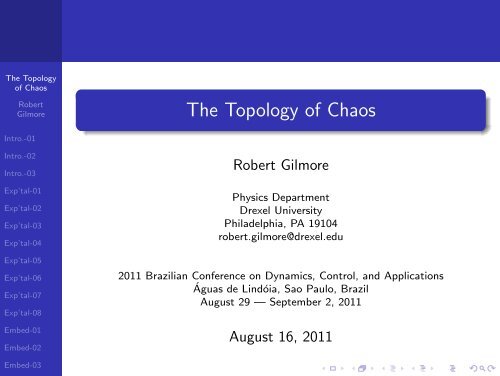
![[PDF] Problem Set #1](https://img.yumpu.com/51299607/1/190x245/pdf-problem-set-1.jpg?quality=85)
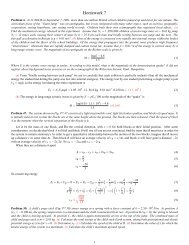
![[PDF] Problem Set #3](https://img.yumpu.com/50150452/1/184x260/pdf-problem-set-3.jpg?quality=85)
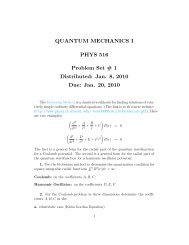

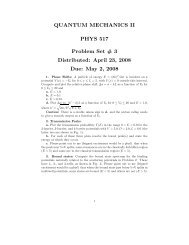
![[PDF] Problem Set #2](https://img.yumpu.com/45468456/1/184x260/pdf-problem-set-2.jpg?quality=85)
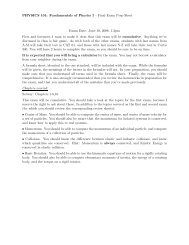
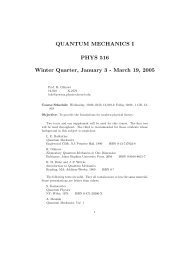
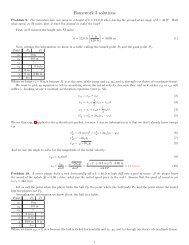
![[PDF] Xiang Liu: Fourier Transform Interferometer](https://img.yumpu.com/39562390/1/190x245/pdf-xiang-liu-fourier-transform-interferometer.jpg?quality=85)
![[PDF] Midterm Template](https://img.yumpu.com/39562028/1/184x260/pdf-midterm-template.jpg?quality=85)

